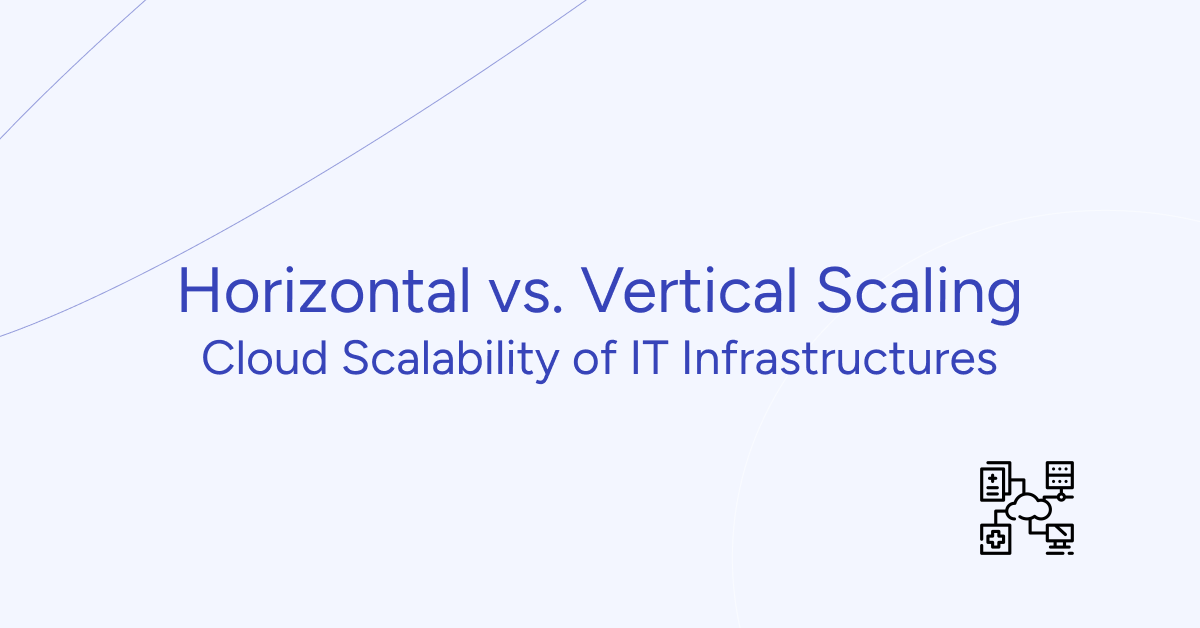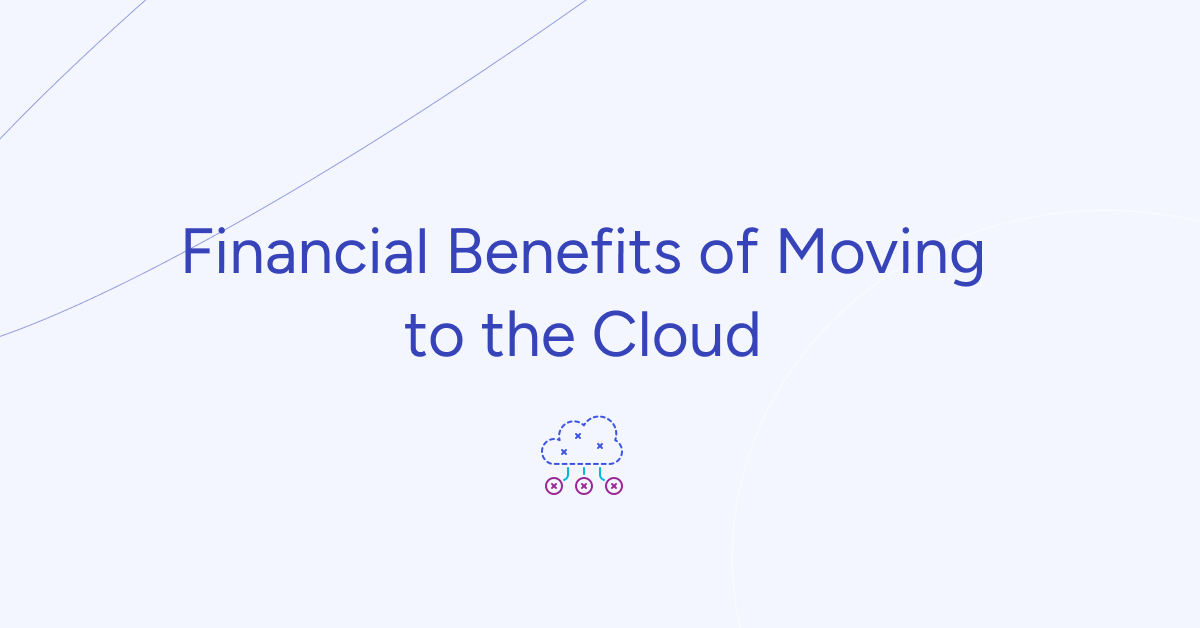- Cloud Scalability
- Vertical Scaling or Scale Up Infrastructure
- When to Scale Up Infrastructure
- Example Situations of When to Scale Up:
- Horizontal Scaling or Scale-Out
- When to scale out infrastructure
- Example Situations of When to Scale Out
- Choosing the Right Approach
- How Gart Can Help You with Cloud Scalability
To maintain smooth operation, you need to scale your resources. This article delves into the two main scaling strategies – horizontal scaling (spreading out) and vertical scaling (gearing up) – Horizontal vs. Vertical Scaling.
Even if a company pauses its processes, does not grow or develop, the amount of data will still accumulate, and information systems will become more complex. Computing requests require storing large amounts of data in the server’s memory and allocating significant resources.
When corporate servers can no longer handle the load, a company has two options: purchase additional capacity for existing equipment or buy another server to offload some of the load. In this article, we will discuss the advantages and disadvantages of both approaches to building IT infrastructure.
Cloud Scalability
What is scaling? It is the ability to increase project performance in minimal time by adding resources.
Therefore, one of the priority tasks of IT specialists is to ensure the scalability of the infrastructure, i.e., the ability to quickly and without unnecessary expenses expand the volume and performance of the IT solution.
Usually, scaling does not involve rewriting the code, but either adding servers or increasing the resources of the existing one. According to this type, vertical and horizontal scaling are distinguished.
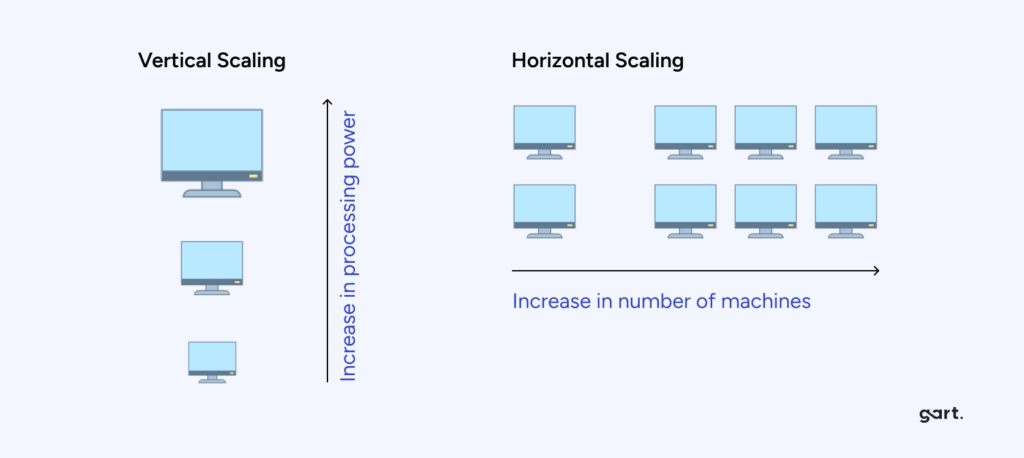
Vertical Scaling or Scale Up Infrastructure
Vertical scaling involves adding more RAM, disks, etc., to an existing server. This approach is used when the performance limit of infrastructure elements is exhausted.
Advantages of vertical scaling:
- If a company lacks the resources of its existing equipment, its components can be replaced with more powerful ones.
- Increasing the performance of each component within a single node increases the performance of the IT infrastructure as a whole.
However, vertical scaling also has disadvantages. The most obvious one is the limitation in increasing performance. When a company reaches its limits, it will need to purchase a more powerful system and then migrate its IT infrastructure to it. Such a transfer requires time and money and increases the risks of downtime during the system transfer.
The second disadvantage of vertical scaling is that if a virtual machine fails, the software will stop working. The company will need time to restore its functionality. Therefore, with vertical scaling, expensive hardware is often chosen that will work without downtime.
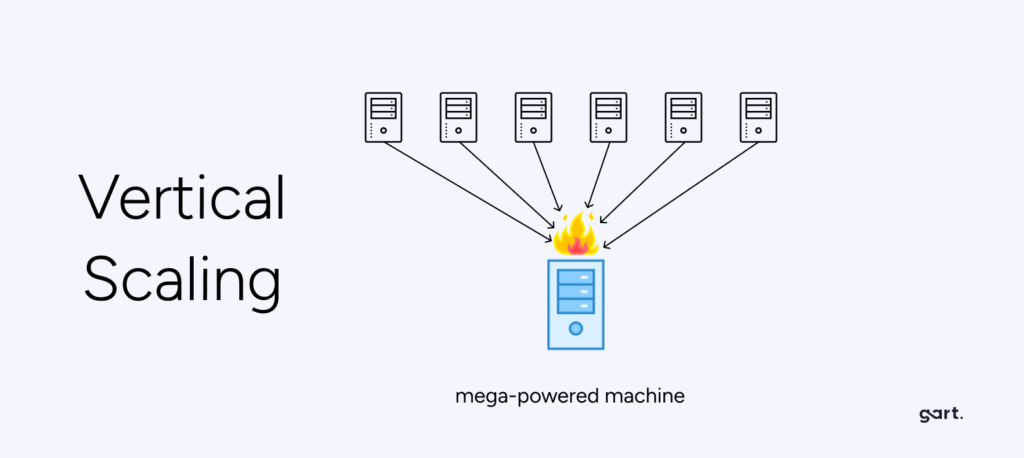
When to Scale Up Infrastructure
While scaling out offers advantages in many scenarios, scaling up infrastructure remains relevant in specific situations. Here are some key factors to consider when deciding when to scale up:
Limited growth
If your application experiences predictable and limited growth, scaling up can be a simpler and more efficient solution. Upgrading existing hardware with increased processing power, memory, and storage can often handle the anticipated growth without the complexities of managing a distributed system.
Single server bottleneck
Scaling up can be effective if you experience a performance bottleneck confined to a single server or resource type. For example, if your application primarily suffers from CPU limitations, adding more cores to the existing server might be sufficient to address the bottleneck.
Simplicity and familiarity
If your team possesses expertise and experience in managing a single server environment, scaling up might be a more familiar and manageable approach compared to the complexities of setting up and managing a distributed system with multiple nodes.
Limited resources
In scenarios with limited financial or physical resources, scaling up may be the more feasible option compared to the initial investment required for additional hardware and the ongoing costs associated with managing a distributed system.
Latency-sensitive applications
Applications with real-time processing requirements and low latency needs, such as high-frequency trading platforms or online gaming servers, can benefit from the reduced communication overhead associated with a single server architecture. Scaling up with high-performance hardware can ensure minimal latency and responsiveness.
Stateless applications
For stateless applications that don’t require storing data on individual servers, scaling up can be a viable option. These applications can typically be easily migrated to a more powerful server without significant configuration changes.
Scaling up ( or verticalscaling) provides a sufficient and manageable solution for your specific needs and infrastructure constraints.
Example Situations of When to Scale Up:
E-commerce platform experiencing increased traffic during holiday seasons
Consider an e-commerce platform that experiences a surge in traffic during holiday seasons or special sales events. As more users flock to the website to make purchases, the existing infrastructure may struggle to handle the sudden influx of requests, leading to slow response times and potential downtime.
To address this issue, the e-commerce platform can opt to scale up its resources by upgrading its servers or adding more powerful processing units. By bolstering its infrastructure, the platform can better accommodate the heightened traffic load, ensuring that users can seamlessly browse, add items to their carts, and complete transactions without experiencing delays or disruptions.
Database management system for a growing social media platform
Imagine a social media platform that is rapidly gaining users and generating vast amounts of user-generated content, such as posts, comments, and media uploads. As the platform’s database accumulates more data, the performance of the database management system (DBMS) may start to degrade, leading to slower query execution times and reduced responsiveness.
In response to this growth, the social media platform can choose to scale up its database infrastructure by deploying more powerful servers with higher processing capabilities and additional storage capacity. By upgrading its DBMS hardware, the platform can efficiently handle the increasing volume of user data, ensuring that users can swiftly retrieve and interact with content on the platform without experiencing delays or downtime.
Financial institution processing a growing number of transactions
Consider a financial institution, such as a bank or credit card company, that processes a large volume of transactions daily. As the institution’s customer base expands and the number of transactions continues to grow, the existing processing infrastructure may struggle to keep up with the increasing workload, leading to delays in transaction processing and potential system failures.
To maintain smooth and efficient operations, the financial institution can opt to scale up its transaction processing systems by investing in more robust hardware solutions. By upgrading its servers, networking equipment, and database systems, the institution can enhance its processing capabilities, ensuring that transactions are processed quickly and accurately, and that customers have uninterrupted access to banking services.
Horizontal Scaling or Scale-Out
Horizontal scaling involves adding new nodes to the IT infrastructure. Instead of increasing the capacity of individual components of a node, the company adds new servers. With each additional node, the load is redistributed between all nodes.
Advantages of horizontal scaling:
- This type of scaling allows you to use inexpensive equipment that provides enough power for workloads.
- There is no need to migrate the infrastructure.
- If necessary, virtual machines can be migrated to another infrastructure without stopping operation.
- The company can organize work without downtime due to the fact that software instances operate on several nodes of the IT infrastructure. If one of them fails, the load will be distributed between the remaining nodes, and the program will continue to work.
- With horizontal scaling, you can refuse to purchase expensive equipment and reduce hardware costs by 20 times.
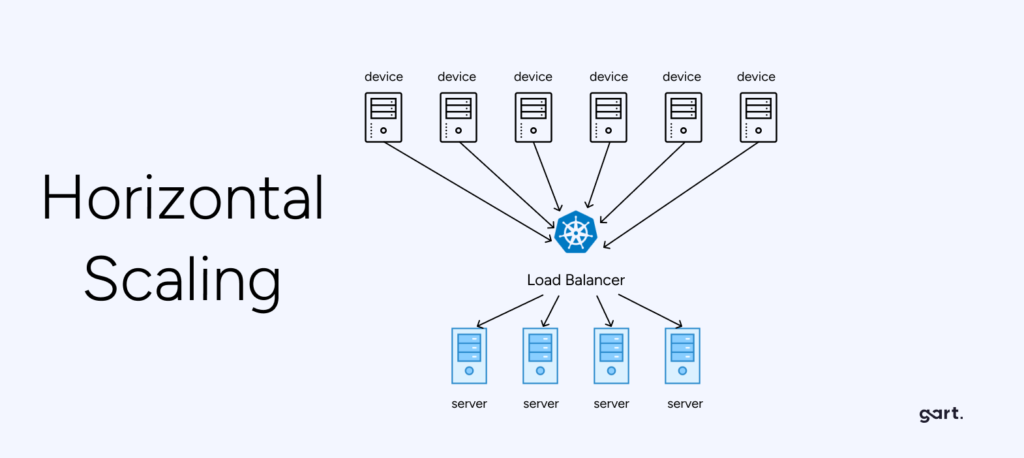
When to scale out infrastructure
There are several key factors to consider when deciding when to scale out infrastructure:
Horizontal growth
If your application or service anticipates sustained growth in data, users, or workload over time, scaling out offers a more scalable and cost-effective approach than repeated scaling up. Adding new nodes allows you to incrementally increase capacity as needed, rather than investing in significantly larger hardware upgrades each time.
Performance bottlenecks
If you experience performance bottlenecks due to resource limitations (CPU, memory, storage) spread across multiple servers, scaling out can help distribute the workload and alleviate the bottleneck. This is particularly beneficial for stateful applications where data needs to be stored on individual servers.
Distributed processing
When dealing with large datasets or complex tasks that require parallel processing, scaling out allows you to distribute the workload across multiple nodes, significantly reducing processing time and improving efficiency. This is often used in big data processing and scientific computing.
Fault tolerance and redundancy
Scaling out can enhance fault tolerance and redundancy. If one server fails, the remaining nodes can handle the workload, minimizing downtime and ensuring service continuity. This is crucial for mission-critical applications where downtime can have significant consequences.
Microservices architecture
If your application employs a microservices architecture, where each service is independent and modular, scaling out individual microservices allows you to scale specific functionalities based on their specific needs. This offers greater flexibility and efficiency compared to scaling the entire application as a single unit.
Cost-effectiveness
While scaling out may require an initial investment in additional servers, in the long run, it can be more cost-effective than repeatedly scaling up. Additionally, cloud-based solutions often offer pay-as-you-go models which allow you to scale resources dynamically and only pay for what you use.
In summary, scaling out infrastructure is a good choice when you anticipate sustained growth, encounter performance bottlenecks due to resource limitations, require distributed processing for large tasks, prioritize fault tolerance and redundancy, utilize a microservices architecture, or seek cost-effective long-term scalability. Remember to carefully assess your specific needs and application characteristics to determine the optimal approach for your infrastructure.
Example Situations of When to Scale Out
Cloud-based software-as-a-service (SaaS) application facing increased demand
Consider a cloud-based SaaS application that provides project management tools to businesses of all sizes. As the application gains popularity and attracts more users, the demand for its services may skyrocket, putting strain on the existing infrastructure and causing performance degradation.
To meet the growing demand and maintain optimal performance, the SaaS provider can scale out its infrastructure by leveraging cloud computing resources such as auto-scaling groups and load balancers. By dynamically adding more virtual servers or container instances based on demand, the provider can ensure that users have access to the application’s features and functionalities without experiencing slowdowns or service disruptions.
Content delivery network (CDN) handling a surge in internet traffic
Imagine a content delivery network (CDN) that delivers multimedia content, such as videos, images, and web pages, to users around the world. During peak traffic periods, such as major events or viral content trends, the CDN may experience a significant increase in incoming requests, leading to congestion and delays in content delivery.
To cope with the surge in internet traffic, the CDN can scale out its infrastructure by deploying additional edge servers or caching nodes in strategic locations. By expanding its network footprint and distributing content closer to end users, the CDN can reduce latency and improve the speed and reliability of content delivery, ensuring a seamless browsing experience for users worldwide.
E-commerce shopping cart
An e-commerce platform utilizes microservices architecture, where each service is independent and responsible for specific tasks like managing shopping carts. Scaling out individual microservices allows for handling increased user traffic and order volume without impacting other functionalities of the platform. This approach provides better flexibility and scalability compared to scaling up the entire system as a single unit.
These examples demonstrate situations where scaling out by adding more nodes horizontally is better suited to handle situations with unpredictable workloads, distributed processing needs, and independent service scaling within a larger system.

Choosing the Right Approach
The decision between horizontal and vertical scaling should be based on specific system requirements, constraints, and objectives.
Some considerations include:
- Workload characteristics: Consider the nature of your workload. Horizontal scaling is well-suited for distributed and stateless workloads, while vertical scaling may be preferable for single-threaded or stateful workloads.
- Cost and budget: Evaluate your budget and resource availability. Horizontal scaling can be cost-effective, especially when using commodity hardware, while vertical scaling may require a more significant upfront investment in high-performance hardware.
- Performance and maintenance: Assess the performance gains and management complexity associated with each approach. Consider how well each option aligns with your operational capabilities and objectives.
- Future growth: Think about your system’s long-term scalability needs. If you anticipate significant growth, horizontal scaling may provide greater flexibility.
Here are some additional tips for choosing the right scaling approach:
- Start with a small-scale deployment and monitor performance: This will help you understand your workload’s requirements and identify any potential bottlenecks.
- Use a combination of horizontal and vertical scaling: This can provide the best balance of performance, cost, and flexibility.
- Consider using a cloud-based platform: Cloud providers offer a variety of scalable and cost-effective solutions that can be tailored to your specific needs.
By carefully considering all of these factors, you can choose the best scaling approach for your company’s needs.
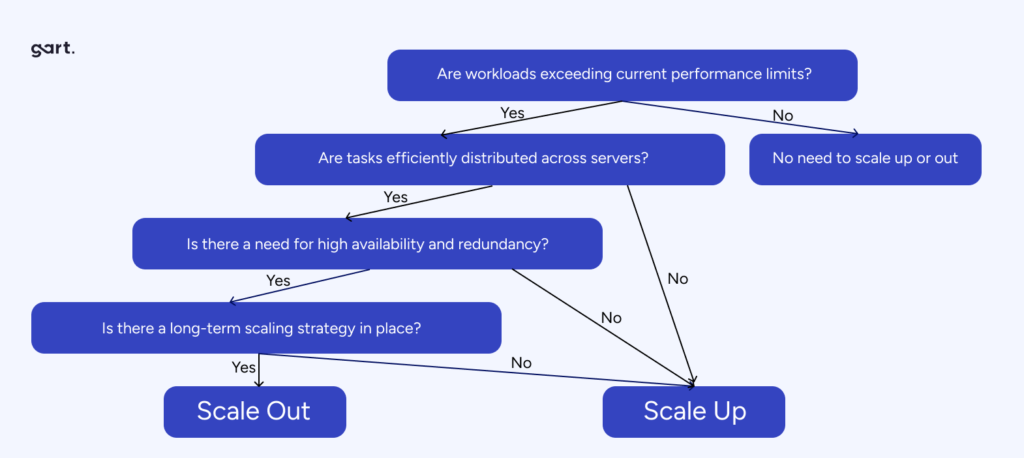
How Gart Can Help You with Cloud Scalability
Ultimately, the determining factors are your cloud needs and cost structure. Without the ability to predict the true aspects of these components, each business can fall into the trap of choosing the wrong scaling strategy for them. Therefore, cost assessment should be a priority. Additionally, optimizing cloud costs remains a complex task regardless of which scaling system you choose.
Here are some ways Gart can help you with cloud scalability:
- Assess your cloud needs and cost structure: We can help you understand your current cloud usage and identify areas where you can optimize your costs.
- Develop a cloud scaling strategy: We can help you choose the right scaling approach for your specific needs and budget.
- Implement your cloud scaling strategy: We can help you implement your chosen scaling strategy and provide ongoing support to ensure that it meets your needs.
- Optimize your cloud costs: We can help you identify and implement cost-saving measures to reduce your cloud bill.
Gart has a team of experienced cloud experts who can help you with all aspects of cloud scalability. We have a proven track record of helping businesses optimize their cloud costs and improve their cloud performance.
Contact Gart today to learn more about how we can help you with cloud scalability.
We look forward to hearing from you!
See how we can help to overcome your challenges

